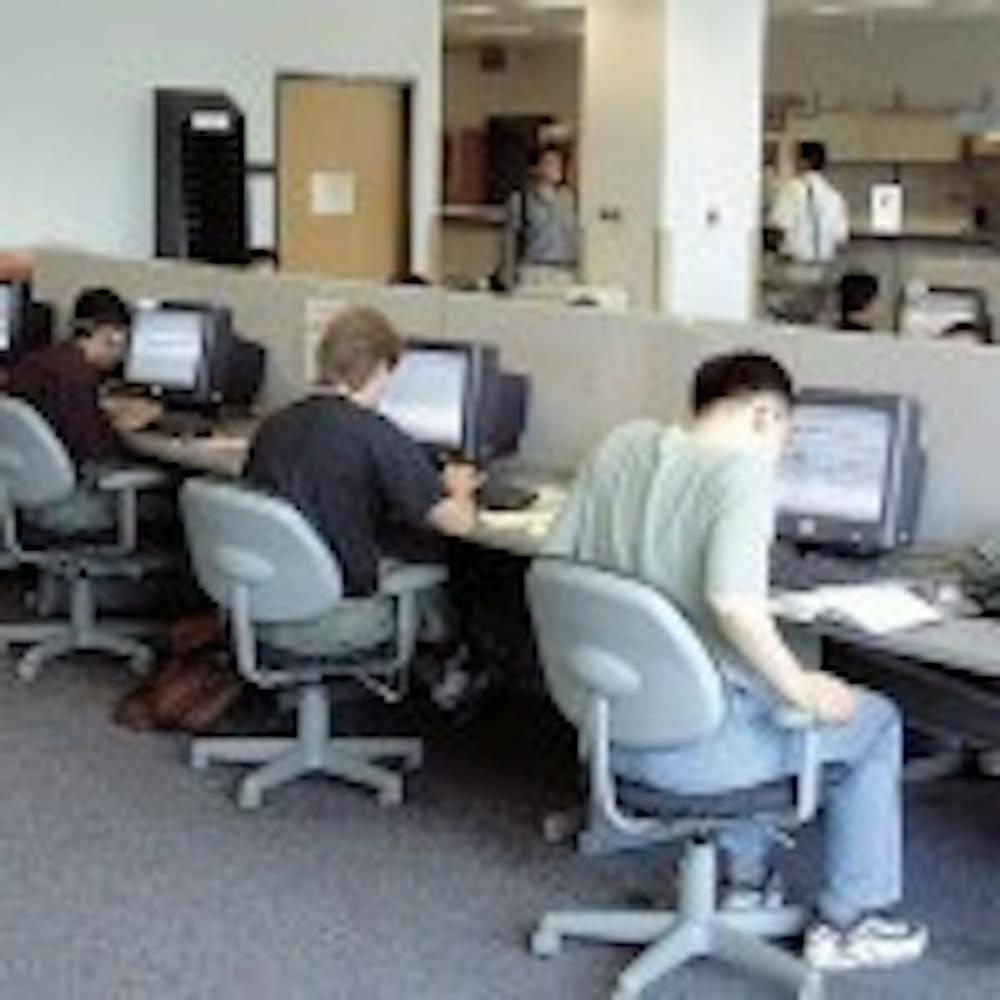UB officially brought Michael Dell and more than 2,000 of his company's computers into its high-tech bioinformatics project Tuesday, creating a $13 million supercomputer that is likely the third most powerful in the world.
The interconnected Dell PowerEdge servers are the latest addition to the university's Center of Excellence in Bioinformatics and the Center for Computational Research, which has secured $61 million in funding in this year's state budget and has attracted approximately $290 million from government and commercial partners over the last two years.
More than 80,000 pounds of hardware have been installed in a former food services space in Norton Hall, just 90 days after signing a purchase contract with Dell Computer Corporation. The system, which contains 4,120 Pentium processors, can perform a combined 5.8 trillion operations per second and increases the CCR's computing power by tenfold.
UB President William R. Greiner said Dell's investment in the bioinformatics program signified an official start to the program. "Having this installation in the thick of UB's Center for Computational Research makes it real, in a very physically firm, tangible way," said Greiner.
The bioinformatics cluster represents Dell's commitment to furthering the recent trend towards Linux and other industry standard cluster systems in computational research, said CEO Michael S. Dell, who was on hand Tuesday for the system's public unveiling.
"We're making investments at UB to ensure the success of clusters," said Dell.
Dell also announced that UB was the first recipient of his company's Centers for Research Excellence award, based on the medical research being conducted by Jeffrey Skolnick, the bioinformatics director, and others at the Center of Excellence that could eventually lead to advanced diagnosis and potential treatments for heart disease, cancer and a variety of other diseases.
With the addition of the Dell cluster and Skolnick, who officially joined the project with his team last Sunday, the project will begin the long process of analyzing the huge amounts of data from the mapping of the human genome last year.
The cluster was "completely full" interpreting the human genome data as of last Friday, said Skolnick, but the center expects to work for about 10 years before seeing the real results of the computational analysis.
"We've been given the opportunity to generate world-class science. Now the burden of proof is on the Center of Excellence in Bioinformatics to produce results," Skolnick said.
Before then, the study of molecular diagrams and the genetic triggers that point to future illness could aid in the development of "personalized medicine," he said, avoiding such treatments as chemotherapy in which "quite often, the treatments are as bad as the disease."
Dell also believes the center will help UB and Western New York attract businesses to downtown Buffalo, where the center's headquarters will be developed at the Buffalo Niagara Medical Campus on Washington Street.
"From what I've seen here today, a large cluster can absolutely attract the best researchers and help start up spin-off companies," said Dell.
Provost Elizabeth D. Capaldi, a major part of the team that raised funds for and organized the bioinformatics center, said the center will likely hire 10 faculty members as research progresses over the next five years, as well as create new undergraduate and graduate programs closely tied to bioinformatics research.
The 2,000-server Linux-based cluster is similar to hundreds of others Dell has installed at universities and research centers such as Johns Hopkins University and Cornell University, said William Rodrigues, Dell's vice president and general manager for education and healthcare. The sheer size of the project, however, led Dell to set up and test the system at a Long Island site prior to its installation at UB.
Rodrigues said the easily upgradable nature of cluster-based systems has created a growing demand for cluster-based systems over the traditional single-unit supercomputer.
UB's supercomputing cluster can perform 5.8 teraflops of instructions, or 5.8 trillion arithmetic calculations, in one day. The same amount of work would take today's high-end personal computer nearly 11 years.
According to the "Top 500," an annual list of the world's most powerful supercomputers compiled by the University of Mannheim, the U.S. Department of Energy and the University of Tennessee, the highest-ranking Linux cluster system in this year's list is the University of Heidelberg Linux Cluster System (HELICS), which ranked number 35 and could perform 825 gigaflops, or .825 teraflops.
Although it has yet to be tested, UB's cluster would place as the third most powerful in the world and the second most powerful in the United States at its purported speed, supplanting the 4.46 teraflop Hewlett-Packard system at the Pittsburgh Supercomputing Center.
Skolnick said the system provides computer students, along with data analysis, physics and even psychology students, a range of research opportunities.
"This is a real good toy for them. It's an excellent learning system," said Skolnick.
Erie County Executive Joel G. Giambra, who along with Buffalo Mayor Anthony M. Masiello spoke at the news conference Tuesday, summed up the "phenomenal team effort put into this project" with a familiar phrase.
"Hey dudes, we've got Dell," said Giambra.





